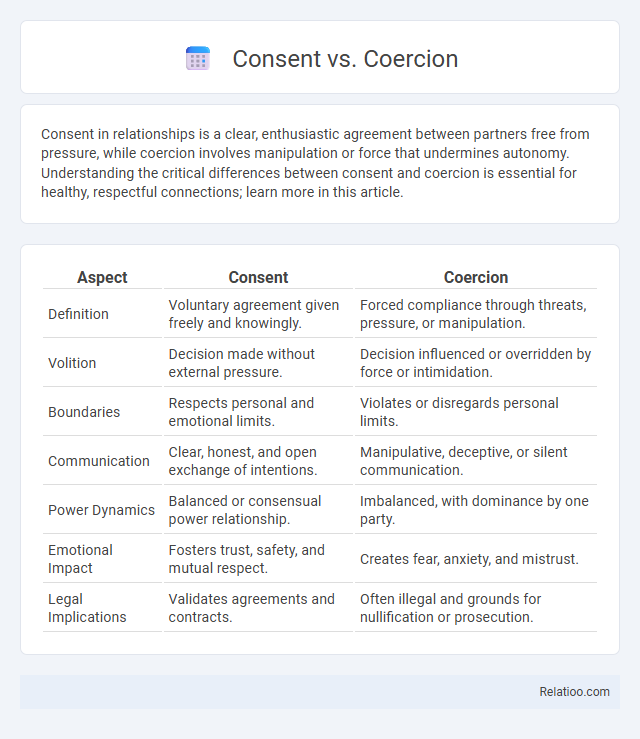Consent in relationships is a clear, enthusiastic agreement between partners free from pressure, while coercion involves manipulation or force that undermines autonomy. Understanding the critical differences between consent and coercion is essential for healthy, respectful connections; learn more in this article.
Table of Comparison
| Aspect | Consent | Coercion |
|---|---|---|
| Definition | Voluntary agreement given freely and knowingly. | Forced compliance through threats, pressure, or manipulation. |
| Volition | Decision made without external pressure. | Decision influenced or overridden by force or intimidation. |
| Boundaries | Respects personal and emotional limits. | Violates or disregards personal limits. |
| Communication | Clear, honest, and open exchange of intentions. | Manipulative, deceptive, or silent communication. |
| Power Dynamics | Balanced or consensual power relationship. | Imbalanced, with dominance by one party. |
| Emotional Impact | Fosters trust, safety, and mutual respect. | Creates fear, anxiety, and mistrust. |
| Legal Implications | Validates agreements and contracts. | Often illegal and grounds for nullification or prosecution. |
Understanding the Concepts: Consent vs Coercion
Understanding the concepts of consent versus coercion is crucial in respecting personal boundaries and legal rights. Consent involves a voluntary, informed agreement made without pressure, while coercion occurs when manipulation, threats, or force are used to obtain compliance. Your ability to distinguish these elements ensures ethical interactions and protects individual autonomy.
Defining Consent: What It Really Means
Consent is a clear, voluntary agreement given by an individual with full understanding of the situation and without any form of pressure or manipulation. It requires mutual respect, informed communication, and the ongoing ability to change one's mind at any time. Distinguishing consent from coercion is essential because coercion involves threats, intimidation, or undue influence that nullifies genuine agreement.
Recognizing Coercion: Signs and Red Flags
Recognizing coercion requires understanding subtle signs such as pressure to comply, manipulation, and lack of voluntary agreement in any interaction. Your ability to identify red flags like fear, guilt, or threats ensures that true consent, free from force or intimidation, is respected and upheld. Awareness of these indicators protects your autonomy and promotes ethical communication in all relationships.
The Importance of Voluntary Agreement
Voluntary agreement is the cornerstone of genuine consent, ensuring that all parties involved make informed and free decisions without pressure or manipulation. Distinguishing between consent, coercion, and genuine agreement helps protect personal autonomy and uphold legal and ethical standards. Recognizing the importance of voluntary consent promotes trust, respect, and clear communication in personal and professional relationships.
Power Dynamics and Their Impact on Consent
Power dynamics critically influence the distinction between genuine consent and coercion, where an imbalance in authority or control can undermine free agreement. Coercion occurs when an individual feels pressured or threatened, rendering consent invalid due to a lack of voluntary choice. Recognizing these dynamics is essential to ensure that consent is informed, freely given, and unaffected by manipulation or power imbalances.
Legal Perspectives: Consent and Coercion in Law
Legal perspectives distinguish consent as a voluntary agreement given without duress, whereas coercion involves the use of threats or force to obtain compliance, rendering purported consent invalid. Courts scrutinize whether consent was freely given, emphasizing the absence of intimidation or manipulation to ensure legality in contracts, sexual offenses, and other legal contexts. The validity of consent hinges on the individual's capacity and the legitimacy of their agreement, with coercion undermining the enforceability and recognition of consent under the law.
Emotional and Psychological Implications
Consent involves mutual agreement and respect, fostering emotional safety and psychological well-being by validating personal boundaries and autonomy. Coercion undermines true consent, causing emotional distress, anxiety, and long-term psychological harm through manipulation or pressure. Understanding these distinctions helps you protect your mental health and maintain healthy relationships grounded in trust and genuine choice.
Societal Norms and Misconceptions
Societal norms often blur the lines between consent and coercion, leading to widespread misconceptions about what constitutes genuine agreement. Coercion undermines true consent by introducing pressure, manipulation, or threats, which distorts your ability to freely choose. Understanding these distinctions is crucial to challenge harmful cultural narratives and promote respect for personal autonomy.
Preventing Coercion: Education and Awareness
Effective prevention of coercion hinges on comprehensive education and awareness programs that clearly define the boundaries of genuine consent versus manipulation or pressure. Empowering individuals with knowledge about personal rights, communication skills, and recognizing coercive tactics fosters environments where consent is freely given and respected. Targeted campaigns and workshops in schools, workplaces, and communities reinforce the importance of mutual respect and legal standards, ultimately reducing instances of coercion.
Promoting a Culture of Informed Consent
Promoting a culture of informed consent requires clear communication, respect for individual autonomy, and ensuring that decisions are made without pressure or manipulation. Informed consent emphasizes transparent sharing of information, allowing individuals to understand risks and benefits fully before agreeing to any intervention. Differentiating consent from coercion is essential to uphold ethical standards and protect personal rights in healthcare, research, and legal contexts.

Infographic: Consent vs Coercion
 relatioo.com
relatioo.com